Estée Lauder (post 1960)
Continued from: Estée Lauder
Estée Lauder was available in Canada by 1958. The company’s first overseas outlet was established shortly afterwards when Estée Lauder personally negotiated a stand in the Harrods department store in Knightsbridge, London which opened in 1960. Griffin & Spalding, a department store in Nottingham, claim to have become Estée Lauder’s second outlet in Britain in February, 1961 after Harrods’ one year exclusivity agreement expired.
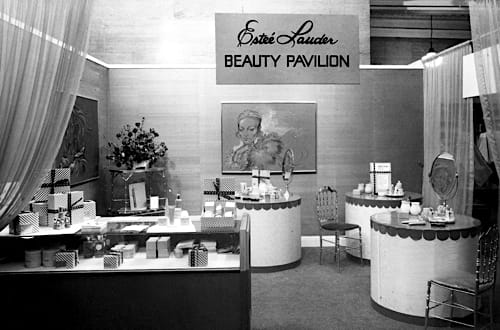
Above: c.1960 Estée Lauder Beauty Pavilion in Harrods.
Other European countries followed in quick succession. Robert M. Worsfold [1926-2018] was hired to head up the growing international division. He oversaw the expansion of Estée Lauder around the world becoming the president of Estée Lauder International, Inc. when it was founded, a position he held until he retired in 1981.
A major part of the expansion plan was the development of new production facilities both in the United States and Overseas. By 1965, Estée Lauder was operating four factories on Long Island at Hyde Park, Garden City, and Westbury as well as a warehouse in Hicksville. Plans were drawn up for a new factory to combine all these operations under one roof in Melville, Long Island that would also include a research and development centre.
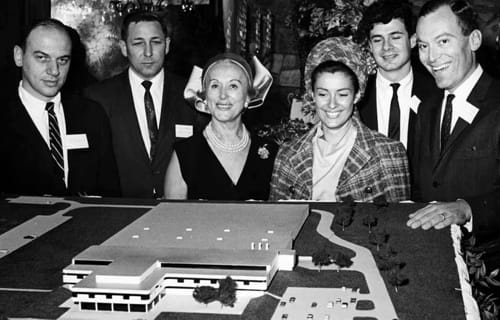
Above: 1965 From left: Sam Brody (engineer), Estée Lauder, Evelyn Lauder, Richard Dattner (architect), and Leonard Lauder, after the groundbreaking ceremony in Melville.

Above: Estée Lauder factory in Melville, Long Island opened in 1967.
In 1966, the company registered Whitman Laboratories, Ltd. in Toronto, Canada, which then established a branch in Britain, opening a Whitman factory in Waterlooville, Hampshire in 1967. European manufacturing facilities were also built in Oevel, Belgium to avoid tariffs and other problems connected to the European Common Market.
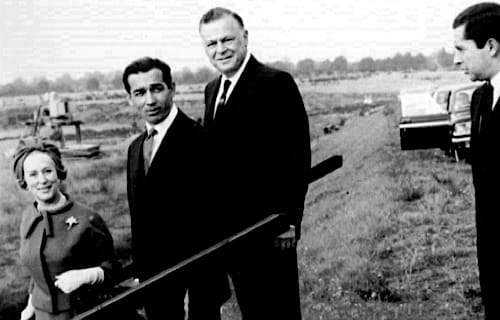
Above: 1965 Estée and Joseph Lauder on their way to lay a foundation stone for the factory in Oevel, Belgium.
As well as expanding, Estée Lauder also diversified its product range in the 1960s. By the end of the decade, the company had established two new ranges – Aramis, a collection of men’s toiletries and cosmetics, and Clinique, a large range of cosmetics for a younger generation of women. I will discuss those later but will first cover developments in the Estée Lauder line during the 1960s.
Estée Lauder
The first new cosmetics added to Estée Lauder in the 1960s were Wonderfirm Creme Plastique (1960) and Creme Hydro-Tone and Hydro-Tone Complete Make-up (1961).
Wonderfirm Creme Plastique, referred to as ‘The Exercise Creme’ was a strawberry-pink, sticky, creamy mask that tingled as it tightened and firmed. Ideally, it was finger-patted for three to five minutes after being spread over the face. Its stickiness would result in the fingers lifting the skin thereby increasing the effects of massaging. The finger-patting was unpopular with many women, ultimately leading to the cream being removed from many markets in the 1970s.
Wonderfirm Creme Plastique: “Performs like a face lift while smoothing away lines and bringing the rosy glow of a peaches and cream complexion.”
Creme Hydro-Tone was made with an ‘exclusive scientific formula’ dubbed HT2, which was claimed to sweep away lifeless tissue, replace essential skin oils and vitamins, and seal in skin moisture. The cream was matched with Hydro-Tone Complete Make-up sold in tubes in eight translucent shades. It was a combination foundation and powder made with the Creme Hydro-Tone base.
Creme Hydro-Tone: “This rich, light creme helps rebuild tissues and gives a complete balance of moisturizing, softening and healing ingredients.”
Hydro-Tone Complete Make-up: “Matte finish complexion color in plastic tubes.” Known shades: Shell-Tone, Ivory-Tone, Beige-Tone, Peach-Tone, Rose-Tone, and Sun-Tone. New Beige, Medium Beige, and Dark Beige were added in 1964; Riviera Bisque in 1965.
By 1962, Estée Lauder had created Creamy Cleanser, its first new cleanser since 1946. Said to be suitable for all skin types, it was recommended primarily for travelling. Because of this it was sold in a plastic bottle and was often combined with Estée Lauder Skin Lotion, and Estroderm Youth Dew Emulsion, also in plastic bottles as a Travel Trio.
1. Creamy Cleanser:
Cleanses, lubricates and softens all types of skin, leaves pores so dean, free from all impurities. Penetrates every incipient wrinkle, smoothing that dried-cut look that ages.
2. Skin Lotion:
Refreshing toner that cools and refreshes, leaves skin crystal clean, form and fresh. Pampers you with the finest care in world for worrisome lines.
3. Estroderm Youth Dew Emulsion
A rich light moisturizer and powder base to help sooth away lines and wrinkles. For a more beautiful you, a beauty preparation of superb quality.(Estée Lauder advertisement, 1965)
For the home facial, Estée Lauder still recommended the previous pattern of Estée Lauder Cleansing Oil, Creme Pack, and Super-Rich All-Purpose Creme, finishing off with Estroderm Creme or Emulsion.
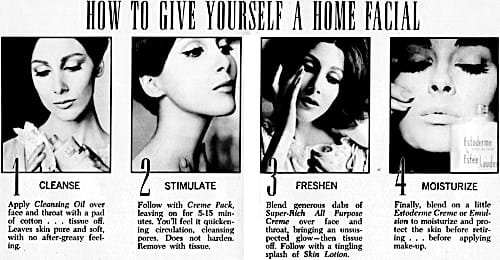
Above: c.1963 Estée Lauder Home Facial.
1 CLEANSE
Apply Cleansing Oilover face and throat with a pad of cotton . . . tissue off. Leaves skin pure and soft, with no after-greasy feeling.
2. STIMULATE
Follow with Creme Pack. leaving on for 5-15 minutes. You’ll feel it quickening circulation, cleansing pores. does not harden. Remove with tissue.
3. FRESHEN
Blend generous dabs of Super-Rich All-Purpose Creme over face and throat, brining an unexpected glow—the tissue off. Follow with a tingling splash of Skin Lotion.
4. MOISTURIZE
Finally, blend on a little Estoderme Creme or Emulsion to moisturize and protect the skin before retiring . . . before applying make-up.(Estée Lauder, c.1963, p. 10)
Skin types
Estée Lauder only made limited allowances for Dry and Oily Skin Types until the late 1960s with many of her products described as suitable for all skin types.
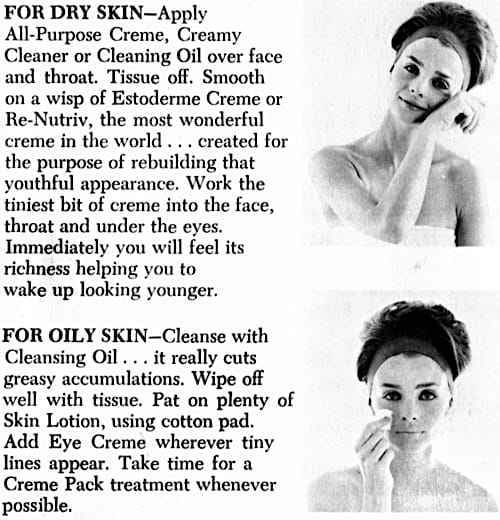
Above: c.1963 Estée Lauder Dry and Oily skin routines.
This changed in 1967 when Estée Lauder debuted six new products aimed at more mature/dry skin types and followed this with five treatments more suited to oily skin in 1968.
The six Fast-Acting Treatments for mature/dry skin that launched in 1967 had Night Table Creme, a night cream, added to them in 1969.
Dry Dry Skin Creme: “Super-rich. Instantly absorbing and invisible so you can wear it 24 hours a day.”
Whipped Cleansing Creme: “[A]iry-light with whipped turtle oil, it whisks away dirt in seconds as it smooths and softens.”
Dry Dry Skin Astringent: “[T]he non-astringent astringent that gently tones even sensitive skin—leaves it smooth and ready for make-up.”
All-Day Eye Creme: “[S]inks, right into delicate skin to give precious moisture under make-up and at night.”
All-Day Throat Creme: “[W]eightless and completely invisible, it helps seal in moisture with swan oil for supple, youthful skin.”
Wrinkle Stick: “[A] blend of lubricants in a swivel tube minimizes lines right over make-up—in a single stroke!”
Night Table Creme: “Smoothed on just before bedtime, its velvety formula full of precious oils and moisturizers works while you sleep to help replenish vital natural lubricants.”
The turtle oil used the Whipped Cleansing Creme had been previously employed in the Estée Lauder All-Purpose Creme and Re-Nutriv Creme but the swan oil in the All-Day Throat Creme looks to have been a new development.
Also see the booklet: How Estée Lauder can help you look younger (c.1963)
The Fresh Water Treatments for oily skin which arrived in 1968 added five new lines to the blue-shaded Active Skin Lotion which Estée Lauder had released in 1966. An additional line, Fresh Mineral Water Spray, was added to the range in 1970.
Gentle Facial Shampoo: “[A] velvety green gel soap to be used morning and night. Leaves skin tingly clean and water-baby soft.”
Active Skin Lotion: “[C]ompletes the nighttime cleansing process (after Gentle Facial Shampoo) with a refreshing toning and conditioning action.”
Facial Milk Rinse: “[S]moothed on lavishly after morning cleansing, this rinse restores the skin’s natural balance and prepares it for moisturizing.”
Non-Oily Under-Makeup Creme: “[H]elps skin retain moisture. Pat over make-up too, to retard oil breakthrough and keep make-up smooth.”
Almond Clay Pack: “[A] clarifying facial mask to help quicken circulation, revive sluggish skin. Use weekly—or more often—as a fifteen-minute beauty ritual.”
Fresh Mineral Water Spray: “[A]n aerosol of crystal-clear pure spring water that sprays on a fine mist of instant refreshment for jaded, faded skin.”
The Non-Oily Under-Makeup Cream was not the first Estée Lauder cream to be formulated for use under make-up. An enriched version had been introduced back in 1965.
Enriched Under Make-up Creme: “[S]mooths, softens, makes a velvety cushion for any foundation. It works outwardly toward a flawless look; works inwardly to keep skin refreshed, gently lubricated.”
See also: Fresh-water treatment essentials from Estée Lauder (c.1968)
Re-Nutriv
In 1960, there were three products in the Re-Nutriv range – the original Re-Nutriv Creme (1956), and Liquid Re-Nutriv; and Re-Nutriv Lipsticks (1958).
New shades of Re-Nutriv Lipsticks added during the early 1960s included: French Raspberry Soda, and Peppermill (1961); Rajah Red, French Peach, Florentine Cherry, and Valencia Coral (1962); and Castilian (1963).
In 1964 the lipstick appears to have been reformulated and placed in a new case. It now in came in sixteen shades – Swiss Strawberry, Grecian Lilac, Sorrento Pink, Capri Pink, Porto Fino Rose, French Apricot, Desert Coral, Spanish Melon, Tropic Tangerine, French Peach, Valencia Coral, Café, Castilian, Peppermill, Sevilla Red, and Florentine Cherry – only some of which were new.
Other shades of Re-Nutriv Lipstick added later included: Spiced Apricot, Brown Sugar, Chilled Melon, and Iced Rosé (1964); Vienna Rose, and Pink Apricot (1965); Pompeii Red, Swedish Blush, Lido Sand, Parisian Peach, French Coral, Pink Grape, and Mayfair Pink (1966); Honeysparkle Peach, Coral Tangerine, Coral Peach, Coral Gold, Pink Rose, Pink Sun, and Pink Mauve (1967); and Apricot Mousse, Apricot Glacé, and Nectarine (1969).
In 1971, Estée Lauder would reformulate the lipsticks as Re-Nutriv Rich Rich Lipsticks in twenty-five shades.
Re-Nutriv Rich Rich Lipstick: “Steeped with vitamins and rare and precious Re-Nutriv ingredients. A never-before combination that delivers super-shine, super-color, super-goodness.” Shades: Coral Tangerine, Portofino Rose, Island Coral, Cultured Pink, Rosewood, Brandied Pink, Quiet Currant, Marigold, French Coffee, Desert Coral, Tawny Violet, Understated Apricot, Coral Peach, Mountain Violet, Romantic Red, Wild Peach, Classic Sherry, Nectarine, Swiss Strawberry, Spanish Melon, Civilized Rose, Castilian, Mayfair Pink, Peppermill, and Grape Punch with Crushed Garnet, Crushed Rubies, Crushed Quartz, Crushed Pink Cameo, Crushed Jasper, Crushed Coral, Crushed Amber, and Crushed Carnelian added later in the year.
Re-Nutriv Liquid-Creme Foundation and Re-Nutriv Face Powder, debuted in 1968. Both products were packaged in frosted glass jars, with golden baroque-sculptured caps.
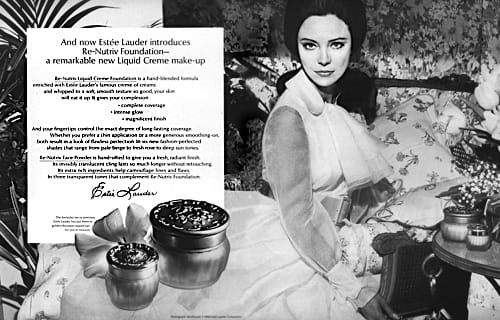
Above: 1968 Estée Re-Nutriv Liquid-Creme Foundation, and Re-Nutriv Face Powder.
Re-Nutriv Liquid-Creme Foundation: “[A] remarkable hand-blended new make-up formulation enriched with her famous creme-of-creams. Whipped to a soft smooth
texture, it lets you control the exact degree of coverage.” Shades: Beige Bisque, Desert Beige, Mayfair Blush, Lido Sun, Honey Blush, and Café Tan.
Re-Nutriv Face Powder: “[A]dds a fresh, radiant finish that clings for hours without retouching. Its extra rich ingredients help camouflage tiny lines and flaws.” Shades: Sheer Bisque, Sheer Glow, and Sheer Tan.
In 1970, Estée Lauder added three new skin-care lines clearly aimed a women with mature, fragile skin – Re-Nutriv Extract, Extremely Delicate Skin Cleanser, and Extremely Delicate Skin Tonic. Re-Nutriv Extract was available in bottles but could also be purchased in capsules, six in each box. It was meant to boost the action of the Re-Nutriv Creme.
Re-Nutrive Extract: “[T]he richest possible concentrate of the rare and precious Re-Nutriv ingredients. To use nightly, in partnership with Re-Nutriv Creme for extra dry areas. Leaves skin feeling softer, fresher, younger. Especially effective as a ‘facial’ during a warm, leisurely bath.”
Extremely Delicate Skin Cleanser: “[A] unique blending of the rich Re-Nutriv ingredients and special cleansing agents. Especially formulated to give the thoroughest cleansing in the gentlest way, it turns to liquid on the skin, to glide off soil and makeup.”
Extremely Delicate Skin Tonic: “The mildest tonic a skin ever tasted. Formulated especially as a follow-up to Extremely Delicate Skin Cleanser, it contains not one drop of alcohol to sting, dry or irritate a super-sensitive skin.”
All these new products meant that women could cleanse, tone, and moisturise their skin, and then apply make-up and lipstick all within the Re-Nutriv range.
Sun-care
The company’s first sun-care cosmetic, Estée Lauder Sun Creme, had been introduced in 1958. New sun-care products started with Sun Souci Bronzing Foam (1963), followed by Après Sun, and Go-Bronze (1966), then Ultra Violet Screening Creme, Surf Creme, and Greaseless Tanning Spray (1968).
Sun Souci Bronzing Foam: “[A] greaseless aerosol foam that absorbs instantly. Use it after sunning to maintain tan.”
Go-Bronze: “It smooths on quickly, dries instantly—under or over make-up—to an ingeniously natural looking golden sheen.” Shades: Early Sun, Golden Sun, and Deep Sun, with Bronze Glow added in 1968.
Ultra Violet Screening Creme: “[A] highly effective screen for strong ultra-violet rays. A light film under make-up ensures deep protection.”
Surf Creme: “[A] smooth, water-resistant sun filter that promotes a light, even tan. Helps retain moisture.”
Greaseless Tanning Spray: “[A] liquid-spray formula that glosses over skin to attract a rich tan. Keeps skin supple.”
Après Sun: “[A] vitamin enriched lotion that soothes the stinging of a sun-tender skin.”
Make-up
New additions to Estée Lauder make-up during the 1960s followed the underlying trends of the decade. Eyes rather than lips became the primary focus of the face while foundations and powders became sheerer.
New make-up products added by Estée Lauder through to 1970 were generally introduced as part of a new collection or look. Starting with the Evening Make-up Collection (1962), these included the Daylight Look, and Golden Diamond Look (1963); Glow, the Viennese Opera Look, and Make-up for Moderns (1965), See-Through Make-up (1966); the Gaelic Beauty Look, the Young City Look, the Classic Country Look, the New Transparencies, and Water Color Tintings (1967); the Glow of the Golden West, and Ready-to-Wear Eye Make-up (1969); and Fresh Air Make-up (1970). However, only some of these are of interest.
Evening Make-up Collection
The Evening Make-up Collection (1962) relied on make-up lines already available in the 1950s but included new shades selected to look well under artificial light: Make-up Base, Face Powder and Powder Compact in Beige, Peach, Rose, and Sun shades; Creme Rouge and Liquid Finishing Rouge in Coral, Blush, and Rose; Evening Lipstick in Frost, Peach, Coral, Blush, Rose, and Cherry; Cake Eyeliner in Black, Brown, Blue, Green, Sea, and Turquoise; and Eye Shadow Colour in Blue, Green, Turquoise, and Violet.
The Evening Lipstick came in a new refillable case but was probably a Re-Nutriv lipstick rather than a reformulation. Later shades that included Florentine Cherry, and Valencia Coral (1962); and French Peach, and Peppermill (1964), were all colours previously found in Re-Nutriv Lipsticks. Other shades were released in conjunction with Re-Nutriv Lipsticks, for example Frosted Grape was launched as an evening accompaniment to Re-Nutriv Pink Grape in 1966.
The ‘Golden Diamond Look’ (1963) and the ‘Vienesse Opera Look’ (1965) were both based on the Evening Make-up Collection but introduced new shades.
Daylight Look
The Daylight Look (1963) followed the Evening range. It included a number of new items in colours selected to look best under the sun. Included in the range were Foundation Film, Powder Film, and Pressed Powder Film Compact in the same shades; Youth Blend Over-Glow; Daylight Lipstick in Orchid Sun, Pastel Sun, Melon Sun, Apricot Sun, Tropic Sun, and Orange Sun shades; Shadow-Light eyeshadow; and Special Formula Cake Mascara in Charcoal, Charcoal-Blue, Charcoal-Green, and Charcoal Brown.
New items in the range included Foundation Film and Powder Film, designed to be used together, Youth Blend Over-Glow, and Shadow-Light eyeshadow which came as a creme and a stick.
Foundation Film: “[A] fluid emulsion foundation . . . melts into the skin to give a velvet soft, dewy look.” Shades: Beige, Honey, Peach, Rose, Sun, and Tropic.
Powder Film: “This sheer light-as-air face powder is specially designed to use over Foundation Film.” Shades: Beige, Honey, Peach, Rose, Sun, and Tropic.
Youth Blend: “A natural-looking color-builder to blend lightly over the contour of the face after applying foundation . . . then add a further touch on the cheekbones after powdering.” Shades: Sun Blend, Rose Blend, and Bronze Blend.
Shadow-Light: “Color-lift your eyes with this soft creamy formulation that beauty treats as it colors, doubles as a daytime eye cream.” Shades: Sky-light, Sea-Light, Lime Light, Beige-Light, Grey-Light, and Turquoise.
Other new make-up
Other new lines added through to 1970 included: Color Contour (1964); Lipstick-In-The Round, which debuted with Make-up for Moderns (1965); Eye Gloss, part of See-Through Make-up range (1966); Tender Make-up Tint/Base, Liquid Glow Tint, Liquid Shadow Tint, and French Beauty Mascara, which came with Water-Color Tintings (1967); Transparent Pressed Powder, part of The Transparencies look (1967); Transparent Color Sticks, Go-Blush, and See-Through Lipsticks from the Glow of the Golden West series (1969); Fresh Air Make-up Base, Face and Cheek Tint, and Tender Lip Tints used in Fresh Air Make-up (1970) and Tender Cheek Tint which formed part of Little Nothings (1970).
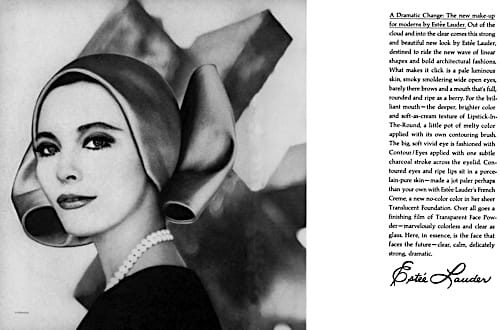
Above: 1965 Estée Lauder Make-up for Moderns.
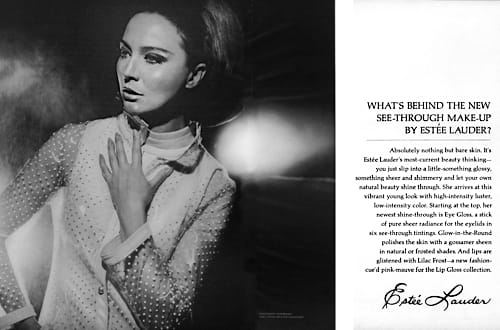
Above: 1966 Estée Lauder See-Through Make-up.
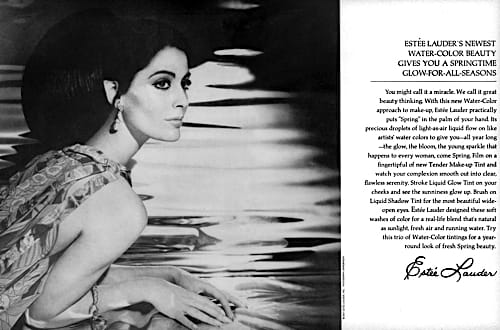
Above: 1967 Estée Lauder Water-Color Beauty.
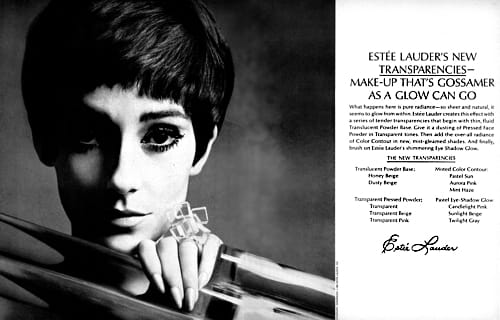
Above: 1967 Estée Lauder New Transparencies.
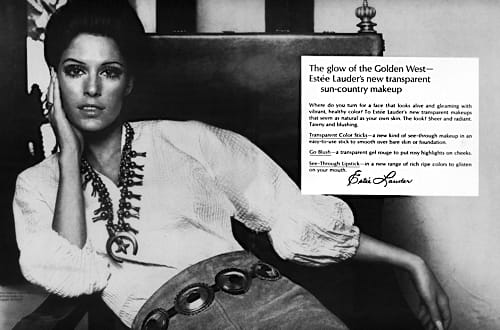
Above: 1969 Estée Lauder Glow of the Golden West.
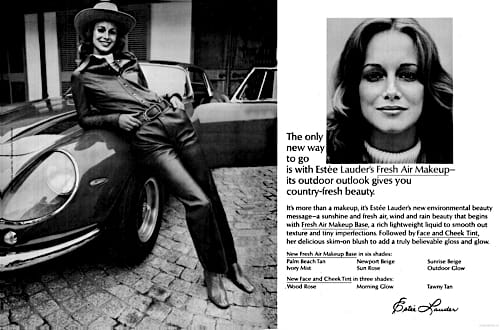
Above: 1970 Estée Lauder Fresh Air Makeup.
Color Contour: “[A]dds a touch of magic.” Shades: Tender Blush, Tender Peach, and Tender Brown.
Lipstick-In-The Round: “[A] little pot of melty color applied with its own contouring brush.” Shades: New Red, New Rose, and New Pink.
Eye Gloss: “[A] stick of sheer radiance for the eyelids.” Shades: Sheer Blue, Green Crystal, Violet Crystal, Natural Crystal, Brown Chiffon, and Grey Pearl.
Tender Make-up Tint/Base: “[A] lightweight liquid foundation smooths out flaws.” Shades: Bare Beige, Sand Beige, Sun Beige, Natural Blush, Porcelain Blush, and Cameo Blush, with Pink Beige added later in the year.
Liquid Glow Tint: “[T]o rinse a blush of beauty over the cheekbones or around the hairline.” Shades: Highlight I, and Highlight II.
Liquid Shadow Tint: “[B]rings a new outlook for eyes.” Shades: Moss, Fawn, Smoke, Azure, Turquoise, and Ivory.
French Beauty Mascara: “[A] creamy cake mascara, applied with water via a super size easy-to-hold brush.” Shades: Black, Brown, Navy, and Charcoal.
Transparent Pressed Powder: “[A] new cream-less formula that’s silky, smooth and weightless.” Shades: Transparent, Transparent Beige, and Transparent Pink.
Transparent Color Sticks: “[C]lear columns of see-through color, give a sunny golden or blushing glow with just a few bold strokes.” Shades: Sierra Sun, Desert Sun, Pecos Pink, Sunrise Blush, and Canyon Rose.
Go-Blush: “[A] transparent gel rouge to put rosy highlights on cheeks.” Known shades: Pecos Pink.
See-Through Lipsticks: “[B]lended from a unique translucent formula that’s designed to make your lips look as if they’re glowing with nature-given color.” Berry Stain Colors: Mulberry, Cocoaberry, Cranberry, Bittersweet, Walnut, Chinaberry with Strawberry, Juneberry, Mayberry, Red Currant, Sunberry, and Sandberry added later in the year. Candied Colors: Butterscotch, Ginger Peel, Pink Mint, and Peach Brandy. Golden West shades: Sundown Glow, Wild Cherry, and Canyon Copper.
Fresh Air Make-up Base: “[A] rich lightweight liquid to smooth out texture and tiny imperfections.’ Known shades: Palm Beach Tan, Newport Beige, Sunrise Beige, Ivory Mist, Sun Rose, Outdoor Glow, Country Creme, Honey Creme, and Toasted Almond.
Face and Cheek Tint: “[A] natural, glowing, skim-on blush that blends beautifully, glows on all day.” Shades: Wood Rose, Morning Glory, and Tawny Tan.
Tender Lip Tints: “[T]urn on the sunshine with little shrugs of color, light and skimmy, and lots of gloss and polish.” Known shades: Cinnamon Ice, Golden Coral, Pink Lights, Polished Beige, Strawberry Shimmer, Sunny Melon, Pink Patent, Honey Pink, Sandstorm, Ciré Coral, Orange Glisten, Fresh Red, Wild Rice, Wild Ginger, Tawny Iris, Crushed Rose, Panne Peach, Blonde Red, Mauve Sparkle, Chilled Sherry, Tawny Port, Sparkling Burgundy, and Cherry Punch. Claret Pink, Rum Swizzle, Mulberry Punch, and Sherry Fizz were added in 1971.
Tender Cheek Tint: “A skim-on, lighter-than-air cheek color to give your skin the shine and texture of a glowing real-life blush.” Shades: Fresh Air Pink, Polished Peach and Afternoon Bronze.
Ready-To-Wear Eye Makeup Collection
In 1969, Estée Lauder turned its attention specifically to eye make-up with its Ready-To-Wear Eye Makeup Collection. Demonstrations of the new range were conducted in stores across the country, some by Jeffrey Bruce, the first make-up artist hired by Estée Lauder.
The collection consisted of: Eyelid Foundation; Under Eye Primer Stick in four shades; Eyebrow Cake in four shades including Blond; Pressed Eyelid Shadow in twenty shades including: Crushed Violet, Plum Raisin, Day Blue, Mauve Mist, Dove Gray, Candlelight Pink, Earth Brown, Black Ruby, Willow Green, Mushroom, Ivory Beige, Smoky Apricot, Sunlight Beige, and Grayed Teal; Solid Creme Eyelid Shadow in Twilight Mauve, Fresh Turquoise, Smoke Blue, Apricot Creme, Green Greige, Sandstone, Moonstone, and Honey Brown; Cake Eyelid Liner, and Liquid Eyelid Liner each in seven shades including Taupe, Neutral-Taupe, Olive, and Black Navy; Eye Glaze to add a pearly effect under the eyebrows; and Lash-Lengthening Cake, and Roll-On Mascaras each in Black Black, Black Brown, Black Navy, Black Green, Black Charcoal, and Black Burgundy.
Added to these were a new set of supporting eye cosmetics: Gentle Eye Liquid Make-up Remover; Professional Eye Make-up Remover Pads; Roll-on Eyelash Night Cream; and Super Clarifying Eye Drops.
Estée Lauder introduced the Ready-To-Wear Eye Makeup Collection with two new eye looks – The Glistening Satin Eye, and The Matte Velvet Eye. Both looks started with Eyelid Foundation, patted in around the eye, followed by Under-Eye Primer Stick, a type of concealer.
Eyelid Foundation: “[P]rotects the skin, and lightens and evens out skin color differences around the eye, and it keeps the makeup on.”
Under Eye Primer Stick: “E]vens out skin tones, especially in the under-eye area. It brightens and lightens a face, when used over furrows.” Shades: Neutraled Flesh, Blued Mauve, and Greened White. Later shades included Skylight Blue, and Midnight Indigo.
The Glistening Satin Eye used Pressed Eyelid Shadow in Black, Ruby, Mushroom, and Sunlight Beige shades, followed by Liquid Eyelid Liner, and Lash-Lengthening Roll-On Mascara both in Black-Burgundy. The Matte Velvet Eye look employed Solid Creme Eyelid Shadow in Fresh Turquoise, followed by Cake Eyelid Liner and Lash-Lengthening Cake Mascara in Black-Green. Both lash-lengthening mascaras contained particles to build up the lashes. Estée Lauder was against using false eyelashes and did not sell them.
Lash-Lengthening Cake Mascara: “A plushy build-up that clings to lashes like a stroke of velvet.” Shades: Black Black, Black Brown, Black Navy, Black Green, Black Charcoal, and Black Burgundy.
Lash-Lengthening Roll-On Mascara: “Naturally longer, glossier eyelashes, no need to fake it.” Shades: Black Black, Black Brown, Black Navy, Black Green, Black Charcoal, and Black Burgundy.
Other eye looks added in 1970 included: The Gaucho Eye, The Twilight Eye, The Daffodil Eye, and The Violet Eye.
Nail Enamel Collection
In 1966, despite growing competition from Revlon, Estée Lauder decided to introduce a range of Nail Enamels starting with Neiman Marcus.
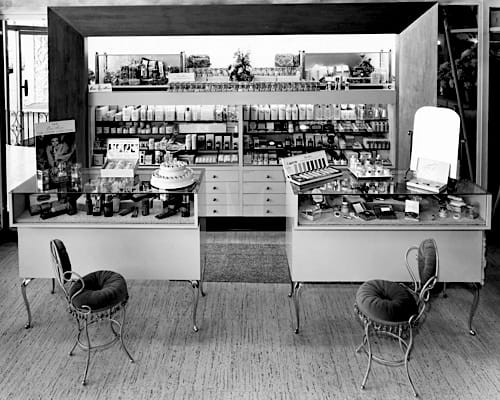
Above: 1966 Estée Lauder stand at Neiman-Marcus with Nail Enamels arrange across the top of the back cabinet.
The Nail Enamel Collection came in forty-three shades, twenty-six cremes and seventeen frosteds, along with a Base Coat, Top Coat, and Remover.
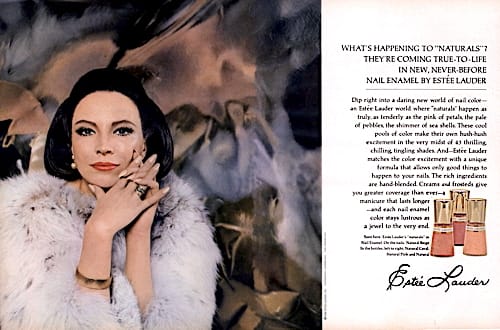
Above: 1966 Estée Lauder Nail Enamel. Included in the shades was a Gold Nail Enamel made with 24K gold.
Nail Enamel: “Sometimes frosted, mostly opaque, these creamy colors have been specially shaded to coordinate with the fashions you like to wear most.” Known shades: Natural, Natural Beige, Natural Coral, Natural Pink, Ripe Plum, Wild Grape, Pink Mauve, Pink Sequin, White Frost, Ivory Lamé, Lido Brown, Precious Rose, Sparkling Rose, Iridescent Rose, Swiss Pink, Peach Ice, Honey Pink, Honey Peach, Honey Banana, and Honey Creme. See-Through Nail Enamel shades – Honeyberry, Sugarberry, Cherryberry, Guavaberry, Loganberry, and Raspberry – were added to match the Berry Stain shades of See-Through Lipsticks in 1968.
Leg make-up
More leg was revealed in the 1960s following the rise of the mini skirt. Estée Lauder responded by introducing a range of leg beauty products.
Waterproof Leg Makeup: “[A] whipped cream foundation that adds color, covers imperfections.” Shades: Natural, and Sun, with Alabaster, Beige, Tropic, and Gold shades in 1967.
Slim Leg: “[A] brown shading powder that creates an illusion of slenderness. Complete with brush.”
Knee Glow: “[A] rosy rouging for behind the knee as well as the knee cap. With puff.”
Satinee Shave: “[A] translucent shave lotion.”
Aramis
In typical fashion, Estée Lauder launched its Aramis range for men in 1963 by handing out small sample bottles in its Gift-with-Purchase offerings. The hope was that women would pass the sample on to their husband or boyfriend.
Most of the items in the original Aramis Collection were typical shaving and hair-care toiletries similar to others already on the market. These included Aramis Cologne, After Shave, Bath Soap, Friction Lotion, Astringent, Shampoo, Soap-on-a-Rope, Grit Soap, Hair Groom Spray, Deodorant, After Shave Cream, After Shave Emulsion, Special Shave Formula, and Shaving Foam.
If your man has been contending with tough beard, rowdy hair, weary eyes or weathered skin—Aramis solves the problem, for these are the imaginative, effective, unique grooming helps distinctive from all others.
(Aramis advertisement, 1965)
However, there were also some non-toiletry items.
Mark-Out: “Disguise blemishes with mat-finish cream that blends with skin. Then it heals what it hides.” Shades: Natural, and Suntan.
Eye Pads: “To cool and soothe if smoke-filled rooms and fine print have taken their toll.”
Pick-Up Mask: “A ten-minute cocktail for the face that’s invisible to others. Refreshes and gives skin the firm tone you started out with.”
All-Weather Hand Cream: “Rushes to the aid of dry, rough or chapped skins with healing agents then sets up water-repellent barricade.”
Later products added to the range during the 1960s included Aramis Bronzing Gel (1966), and Aramis High Altitude Cream, Active Sport Cream, Weather Shield, and Après Ski (1967). Some products appear to have been similar to those in the Estée Lauder sun-care range.
Bronzing Gel: “[A] transparent concentrated skin toner, color-coded in three shades to correct a man’s skin tone for a year round summer glow.” Shades: Transparent, a-1, and a-2.
High Altitude Cream: “[D]esigned for 3,000 feet and above. It’s greaseless and provides extra protection against ultra-violet rays and wind.”
Active Sport Cream: “[A]bsorbs instantly to promote tanning all through the winter sports season while it prevents drying and flaking.”
Weather Shield: “[A]n extra large lubricating stick that protects face, hands and ears with a few fast strokes.”
Après Ski: “[G]oes on after a shower. Its vitamin enriched formula prevents weathering caused by harsh wind, cold, sun-glaze and ‘snow spray’.”
Aramis took a number of years to become profitable, a situation perhaps prolonged by a decision made by Leonard Lauder that he later admitted was a mistake. After he created a separate division within Estée Lauder for Aramis in 1964 he moved the range to its own counter. This meant women would no longer impulse buy an Aramis gift for their significant other at an Estée Lauder counter.
The Aramis 900 Collection (1970) was a smaller collection of men’s products for the hair and scalp, body, face and shave. A number of the skin-care products seem to have originated in Clinique that were modified with men in mind so were also advertised as developed by a dermatologist. The products were selected by men answering eight questions on the Aramis 900 Programmer, a card which punched out the answer to a number of questions, another idea taken from Clinique. Turning the card over revealed which products of the sixteen or so products in the line were recommended. There are suggestions that the card may have been used to generate a print-out in some department stores by 1971.
Clinique
Estée Lauder’s primary audience was women with more mature skin. Hoping to appeal to a younger generation of women, Estée Lauder created its Clinique range in 1968.
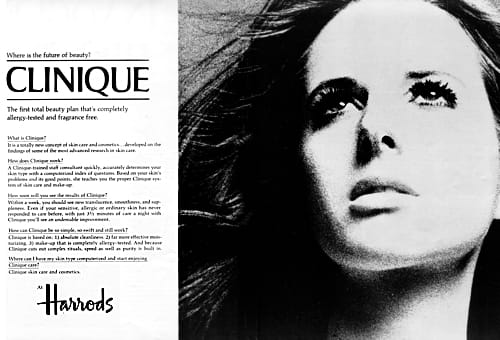
Above: 1969 Clinique launched in Harrods, London.
The idea for Clinique appears to have come from Leonard Lauder but two other names are associated with the line – Carol Philips and Dr. Norman Orentreich. Carol Philips was the Beauty and Special Projects Editor at Vogue before she was hired by Leonard Lauder to head up Clinique. She was looking for a change after being passed over as editor-in-chief for Vogue by Diana Vreeland [1903-1989] in 1963. Dr. Norman Orentreich, a well-known New York dermatologist, was engaged to develop the line. Carol Philips had met Dr. Norman Orentreich when she interviewed him for an article titled ‘Can great skin be created?’ published in Vogue in August 15, 1967. A number of writers have suggested that the article was the inspiration for the development of Clinique but Leonard Lauder rejects this.
Later on, everyone would attribute Clinique to that Vogue article. In truth, I had never read it. It was pure serendipity, one of those ideas floating in the air. Carol and I just happened to snatch it simultaneously.
(Lauder, 2020, p. 194)
Estée Lauder had introduced a small product range for a younger market in the 1950s but it had failed. In order to avoid a similar outcome the new Clinique range would be more comprehensive and promote itself as scientifically based, allergy tested, and fragrance free. To help ensure that its products were both fragrance free and less likely to produce an allergic reaction, Clinique used refined petroleum products such as petrolatum and mineral oil in many of its lines and the products were all allergy tested before they came on the market.
The original Clinique lineup debuted with 117 products encompassing skin-care, body-care, hair-care, and make-up. Fortunately, Estée Lauder had opened a new research and development laboratory in 1967 so was in a good position to conduct the necessary work.
Leonard Lauder reasons for developing Clinique included declining growth rates for the Estée Lauder range, changing demographics associated with the rise of the baby boomers, the development of suburban shopping mall, and the resulting decline of the department store. The problems faced by department stores were a major issue for Estée Lauder as they were the basis for its reputation as a high-status brand. If it tried to improve sales by opening up in other outlets this could put that status at risk.
To avoid any possibility of Clinque contaminating the status of the Estée Lauder brand, Clinique was set up with its own counter in department stores and there were no references to the parent company. The Clinique name was selected to reinforced the scientific nature of the brand and this was bolstered by dressing the behind-the-counter sales staff in outfits that looked like laboratory coats. They also carried penlights to examine a customer’s skin and used the ‘Clinique computer’ to make product recommendations. Products were also packaged in minimalist, scientific-looking packages, frequently using pale greens and silver.
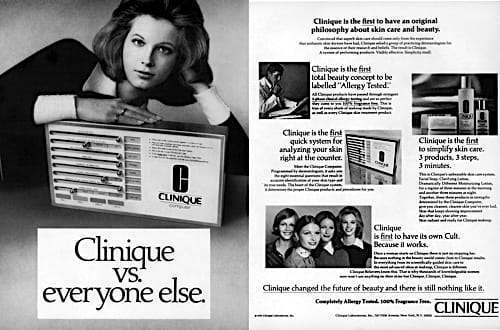
Above: 1972 Clinique.
The underlying rational for Clinique skin-care treatments was provided by Dr. Norman Orentreich. Amongst other things, he recommended exfoliation after cleansing, a novel approach for the time.
After cleansing, what next? We do what we call “exfoliation,” removal of the unnecessary outer layers of the skin, We go “scurfing,” you might say, taking away the scaly scurf that everybody has and nobody needs. Scurf is one layer that prevents see-through skin, makes it lifeless, opaque. How do you remove scurf and can it be done at home? We tech people how to, and urge the to do it at home. The medium is a mild astringent, a mild peeler such as salicylic acid. The treatment gets combined with a moisturising lotion, a lubricator; the stronger the peeler, the more the lubrication.
(‘Can Great Skin be Created?,’ 1967, pp. 113, 117)
Exfoliation is not completely risk free as it removes skin cells containing melanin which help protect the skin from ultraviolet light. However, it became a part of the Clinique three-step routine – cleanse, exfoliate, and moisturise. Soap was frequently recommended as the cleanser, and the Toning Lotion that followed contained an exfoliant such as salicylic acid. The routine was completed with a moisturiser which was de rigueur in any skin-care routine by the late 1960s.
Dr. Orentreich had pioneered a three-step skincare method for his patients—so fundamental today, yet utterly trailblazing back then: cleanse, exfoliate, and moisturize. His dicta: perform that regimen, tailored to your skin type, twice each day, and you would see incredible results.
He developed formulas for the creation of the Clinique brand and led the creation and execution of the allergy testing of each of these formulas—testing every single formula and if there was even one reaction, going back to the drawing board to reformulate.(Lauder, 2020, pp. 193-194)
Like Aramis, Clinique initially lost money. As a private company, Estée Lauder did not have to justify this to shareholders and it now had the resources to cover Clinque’s losses until the range became profitable many years later.
Revlon
Any discussion of developments at Estée Lauder in the 1960s needs to include Revlon. As Leonard Lauder recognised, Revlon was the giant of American beauty in 1960, followed by Elizabeth Arden at number two, then Helena Rubinstein and Charles of the Ritz (Lauder, 2020, p. 169). Noticeably missing from this list is Avon but they were not a direct competitor.
Revlon was the most aggressive company of the four mention and Leonard Lauder suggests that Charles Revson [1906-1975] of Revlon vigorously tried to counter the rise of Estée Lauder by copying its products and promotional methods.
There was a joke that went around our offices: “50 percent of Revlon’s R&D is done here.” Certainly, the new game in the cosmetic industry was “Follow the Lauder.”
(Lauder, 2020, p. 184)
Copying was nothing new in the cosmetics industry and Estée Lauder also frequently engaged in the practice – she would say that her copies were better than the original. Revson copied Estée Lauder not only to counter its rise, something he had done to other companies very effectively in the 1950s, but also because he was worried about Revlon’s declining status.
Unfortunately for Revlon, one of Revson’s strategies was working against him. His determination to cover all aspects of the cosmetic market, to become the ‘General Motors of the cosmetic industry’ meant that he continually expanded the reach of the Revlon brand. Unfortunately, the exclusivity and status that Revlon once held was diluted every time its product range was widened.
Also see: Revlon (post 1960)
Estée Lauder avoided this problem either by creating new businesses each time it moved into a new segment of the cosmetic market or by buying up companies that were already strong in those areas and maintaining their identity. This started with Clinique and there are still many who do not know that it is an Estée Lauder brand. In this way, the company could sell cosmetics covering a wide variety of price points and target markets while maintaining the status of the Estée Lauder name.

Above: 2018 Estée Lauder companies organised by price point and lifestyle (Annual Report, 2018).
Estée Lauder also circumvented another problem experienced by Revlon. When Estée Lauder went public in 1995, the majority of the shares, and therefore control of the company, remained in the hands of the Lauder family. This protected the company from takeover disasters such as the one Revlon experienced when it was acquired by Pantry Pride in 1985 and was saddled with a mountain of debt. Coincidentally, it was around this time that Estée Lauder’s sales began to outstrip Revlon’s.

Above: Total net sales for Avon, Estée Lauder and Revlon 1950-1999 (Modified from Koehn, 2001 p. 189).
Later developments
Helena Rubinstein died in 1965 followed by Elizabeth Arden in 1966 leaving Estée Lauder as the only remaining ‘beauty queen’. By the time she retired in 1994, the company she started with Joseph was well on its way to becoming one of the world&rquo;s largest cosmetic conglomerates.
Timeline
| 1960 | Estée Lauder Cosmetics, Ltd. founded in London. New Products: Wonderfirm Creme Plastique; and Creamy Milk Bath. |
| 1961 | New Products: Creme Hydro-Tone; and Hydro-Tone Complete Make-up. |
| 1962 | New Products: Foundation Film; Powder Film; and Youth Blend Over-Glow. |
| 1963 | Fragrance Products becomes Estée Lauder, Inc. Lonson showroom and offices opened at 18 Davies Street. New Products: Aramis range; and Sun Souci Bronzing Foam. |
| 1964 | Aramis, Inc. established. Estée Lauder Hemisphere Corporation founded. New Products: Color Contour. |
| 1965 | New Products: Enriched Under-Make Up Creme; Glow-In-The-Round; and Lipstick-In-The-Round. |
| 1966 | Whitman Laboratories, Ltd. registered in Ontario, Canada and a branch established in Britain. New Products: Active Skin Lotion; Après Sun; Go-Bronze; Youth Sheen; Glossamer Lip Gloss; and the Nail Enamel Collection. |
| 1967 | Long Island factory opened. Research and development laboratory opened in Melville, New York. Whitman Laboratories factory established Waterlooville, Hampshire, England. New Products: Dry Dry Skin Creme; Whipped Cleansing Creme, Dry Dry Skin Astringent; All-Day Eye Creme; All-Day Throat Creme; Wrinkle Stick; Tender Make-up Base; Liquid Glow Tint, Liquid Shadow Tint, and French Beauty Mascara. |
| 1968 | C. L. Allergenics, Inc. founded in New York. New Products: Clinique range; Re-Nutriv Liquid-Creme Foundation; Re-Nutriv Face Powder; Gentle Facial Shampoo; Facial Milk Rinse; Non-Oily Under-Makeup Creme; Almond Clay Pack; Ultra-Violet Screening Creme; Surf Creme; and Greaseless Tanning Spray. |
| 1969 | Estée Lauder International, Inc. founded in Belgium. New York headquarters moved to 767 Fifth Avenue. Second factory opened in Old Westbury, Long Island. Clinique introduced into Britain. New Products: Azurée; Clinique Very Emolient Cream; and Night Table Creme. |
| 1970 | London offices moved to 71 Grosvenor Street. New Products: Re-Nutriv Extract; Extremely Delicate Skin Cleanser; Extremely Delicate Skin Tonic; Aramis 900; Fresh Mineral Water Spray; Fresh Air Make-up Base; and Clinique sun-care range. |
| 1971 | New Products: Re-Nutriv Rich Rich Lipstick. |
| 1973 | C. L. Allergenics becomes Clinique Laboratories, Inc. Estée Lauder AG founded in Lachen, Switzerland. |
| 1974 | New Products: Aramis 900 Chromatics. |
| 1975 | Mentzer Holdings, Inc. established. |
| 1976 | New Products: Clinique for Men range. |
| 1977 | Swiss factory opened in Lachen. Whitman Laboratories factory moves to Petersfield, Hampshire, England. |
| 1979 | New Products: Prescriptives range. |
| 1982 | New Products: Night Repair Cellular Recovery Complex. |
| 1987 | New Products: Lab Series Skincare for Men. |
| 1990 | New Products: Origins range. |
| 1993 | Global license agreement signed with Tommy Hilfiger. |
| 1994 | Acquires majority interest in M·A·C. |
| 1995 | Estée Lauder goes public on the New York Stock Exchange. Acquires Bobbi Brown and La Mer; and Global license agreement signed with Kiton. |
| 1997 | Global license agreement signed with Donna Karan; buys Aveda. |
| 1998 | Full ownership of M·A·C completed. |
| 1999 | Acquires Jo Malone, London. |
| 2000 | Acquires Bumble and bumble. |
| 2003 | Global license agreement signed with Michael Kors; Acquires Darphin. |
| 2004 | BeautyBank subsidiary established which launches Flirt!, Good Skin, and American Beauty ranges. |
| 2005 | Global license agreements signed with Tom Ford, Sean John, and Missoni Profumi. |
| 2006 | Agreement signed with Coach, Inc.; Daisy Fuentes Beauty developed by Beautybank. |
| 2008 | Prescriptives stores closed. Grassroots Research Labs introduced by Beautybank. |
| 2009 | Acquires AGI Dermetics and Ojon Corporation. |
First Posted: 20th September 2023
Last Update: 12th March 2025
Sources
Can Great Skin be Created? (1967, August 15). Vogue, 112-113, 117.
Estée Lauder. (c.1963). How Estée Lauder can help you look younger [Booklet]. New York. Author.
Estée Lauder. (c.1968). Beauty-care seeks new depth with fresh-water treatment essentials from Estée Lauder [Booklet]. New York. Author.
Israel, L. (1985). Estée Lauder. Beyond the magic. London: Arlington Books.
Koehn, N. F. (2001). Brand new: How entrepreneurs earned consumers’ trust from Wedgewood to Dell. Boston: Harvard Business School Press.
Koehn, N. F. (2001). Estée Lauder: Self definition and the modern cosmetics market. In P. Scranton (Ed.), Beauty and business: Commerce, gender and culture in modern America (pp. 217 -251). New York: Routledge.
Lauder, E. (1985). Estée. A success story. New York: Random House.
Lauder, L. A. (2020). The company I keep. My life in beauty. New York: Harper Business.
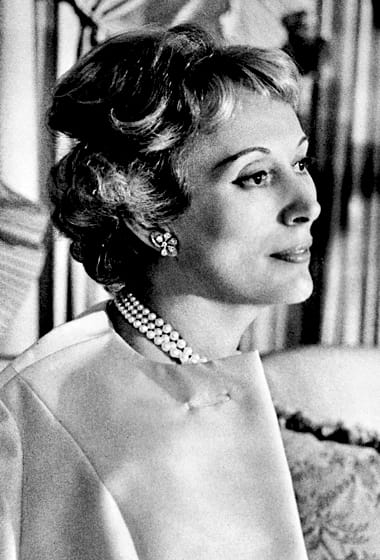
Estée Lauder (née Mentzer) [1908-2004] a.k.a. Josephine Esther Mentzer, Esther Lauter, Estelle Lauter, and Estelle Lauder.
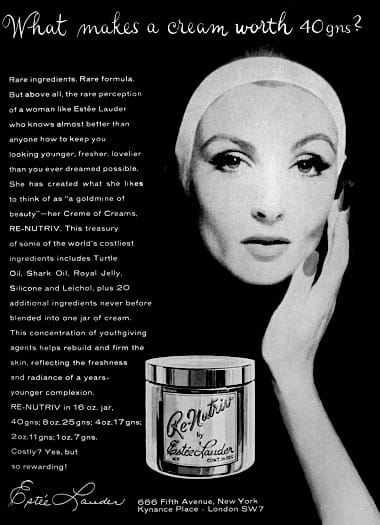
1961 Estée Lauder Re-Nutriv (Britain).
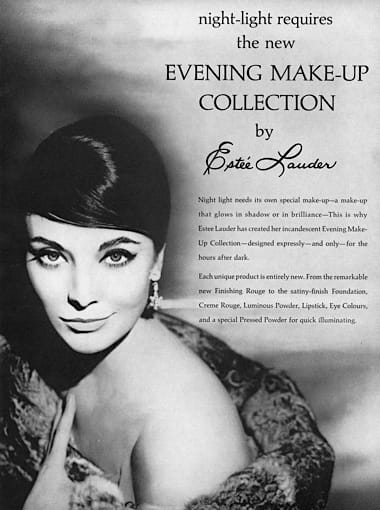
1962 Estée Lauder Evening Make-up Collection.
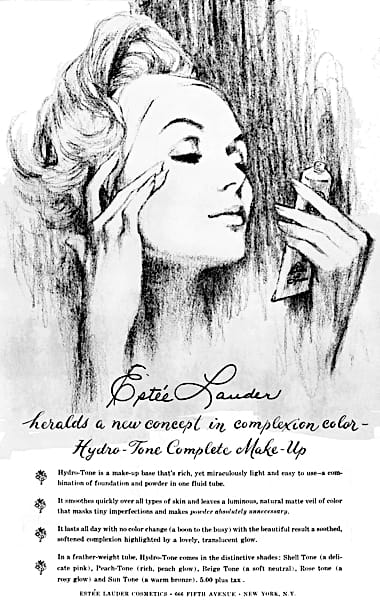
1962 Estée Lauder Hydro-Tone Complete Make-up.
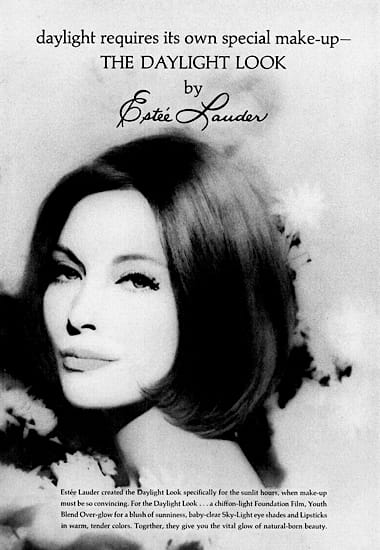
1963 Estée Lauder Daylight Look.
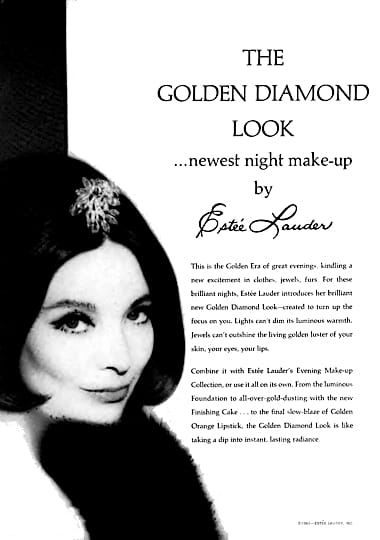
1963 Estée Lauder Golden Diamond Look.
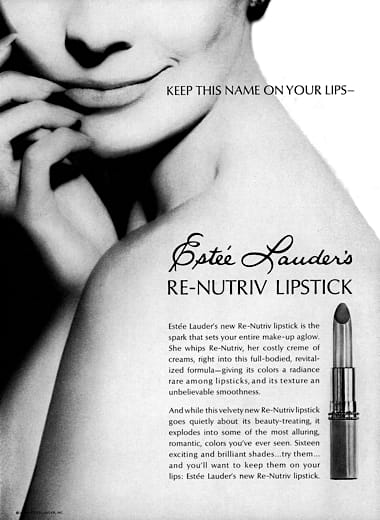
1964 Estée Lauder Re-Nutriv Lipsticks.
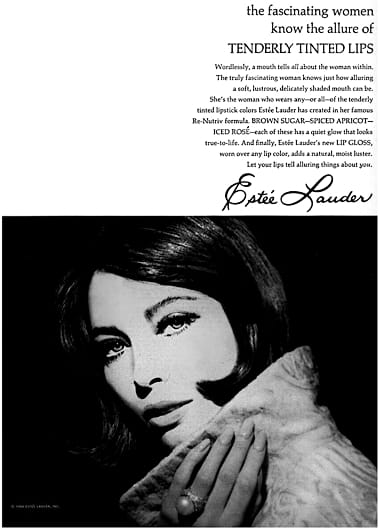
1964 Estée Lauder Brown Sugar, Spiced Apricot, and Iced Rosé Re-Nutriv Lipsticks.
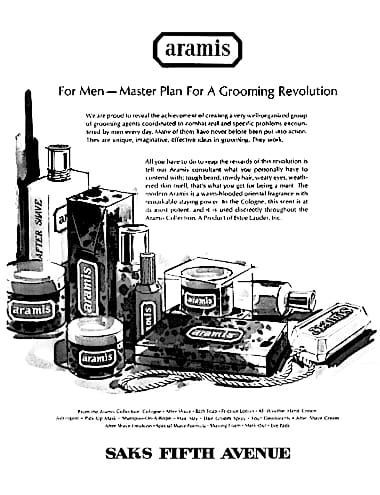
1964 Aramis Collection.
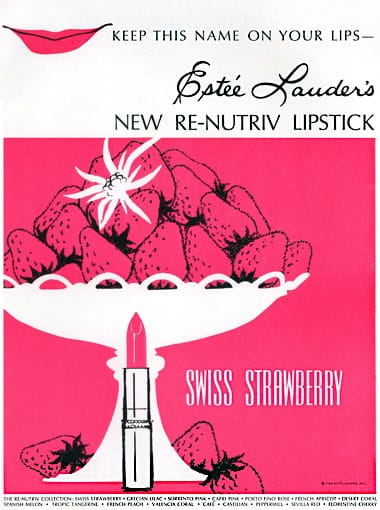
1964 Estée Lauder Swiss Strawberry Re-Nutriv Lipstick.
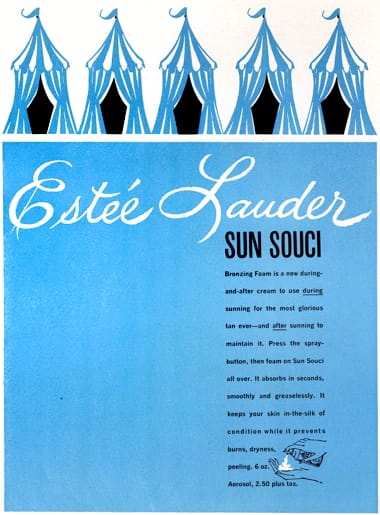
1963 Estée Lauder Sun Souci Bronzing Foam.
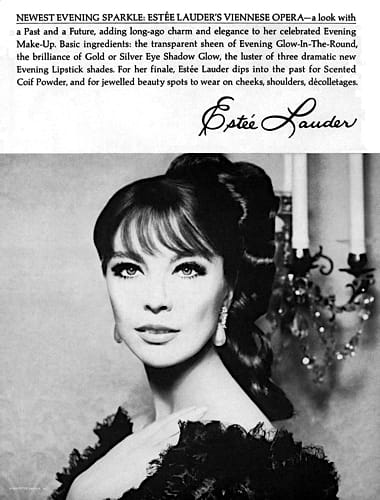
1965 Estée Lauder Viennese Opera Look.
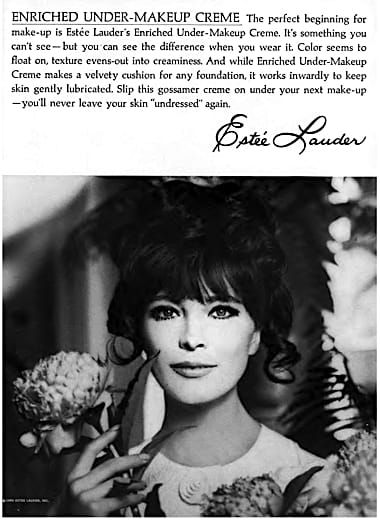
1965 Estée Lauder Enriched Under-Makeup Creme.
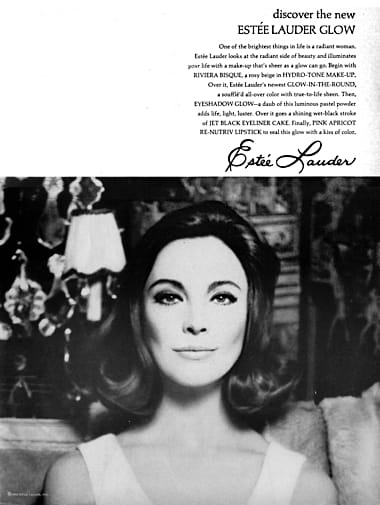
1965 Estée Lauder Glow (Britain)..
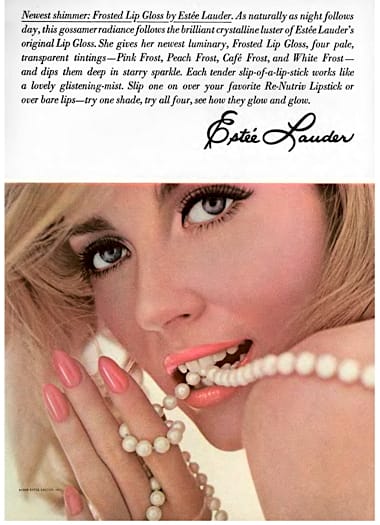
1965 Estée Lauder Frosted Lip Gloss.
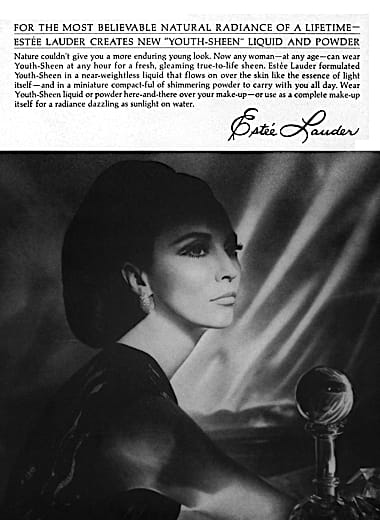
1966 Estée Lauder Youth Sheen.
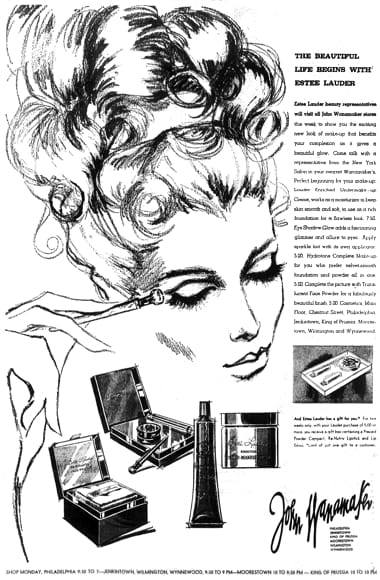
1966 Estée Lauder. From left to right: Translucent Face Powder, Eye Shadow Glow, Hydrotone Complete Make-up, and Enriched Under Make-up Creme.
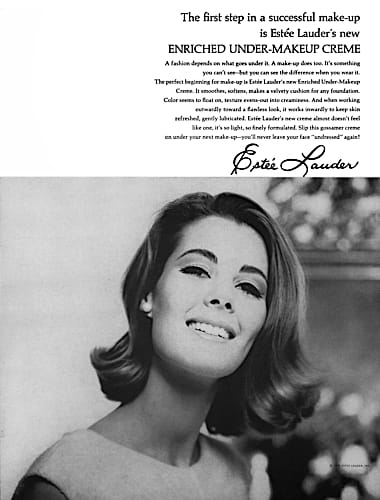
1966 Estée Lauder Enriched Under-Makeup Creme.
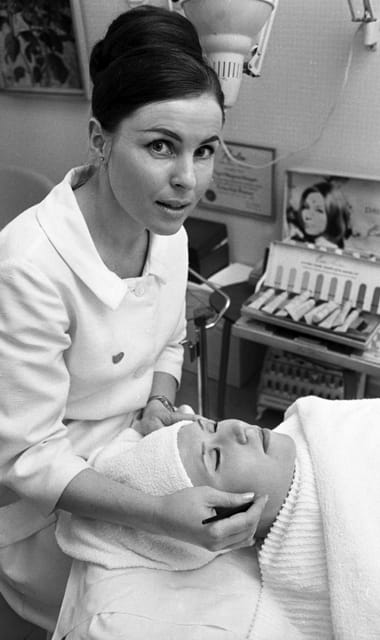
1966 Therapist conducting a facial in a salon. A box of Estée Lauder Hydro-Tone Complete Make-up in 8 shades looks to be in the background.
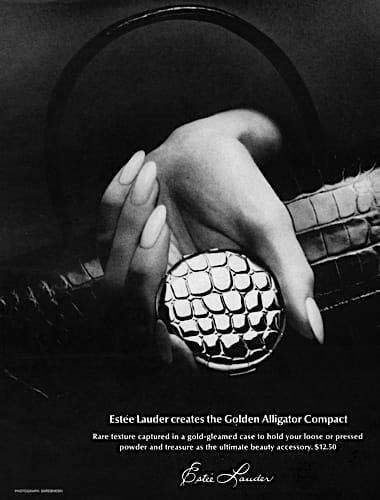
1967 Estée Lauder Alligator Compact. It came in two forms – for loose powder and compressed.
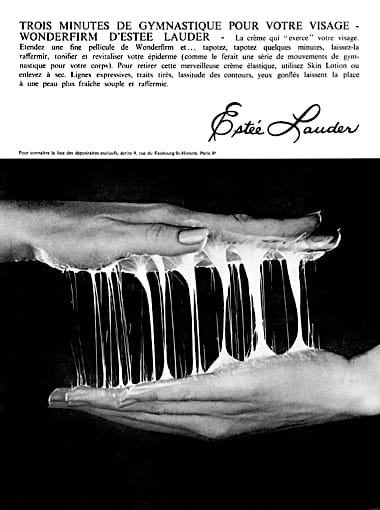
1967 Estée Lauder Wonderfirm (France).

1967 Estée Lauder Honey-Bares in ‘barely-there’ shades. Lipsticks shades: Honeysparkle Rose, Honeysparkle Peach, Honeysparkle Ice, and Honeysparkle Blush. Nail Enamel shades: Honey Pink, Honey Peach, Honey Banana, and Honey Creme.
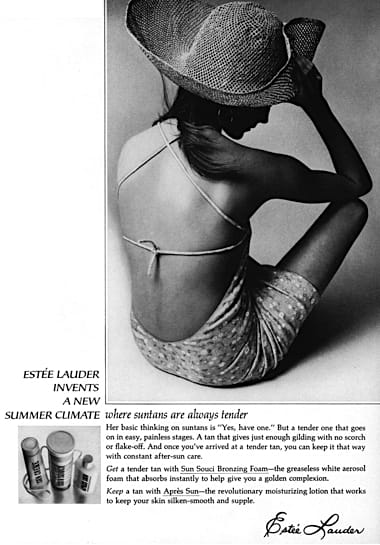
1967 Estée Lauder Sun Souci Bronzing Foam, and Après Sun.

1967 Estée Lauder Waterproof Leg Make-up.
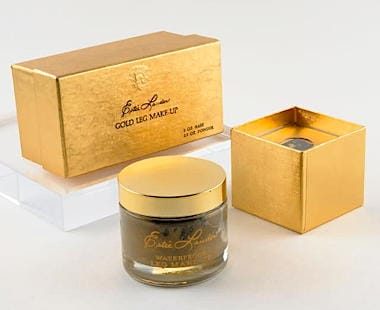
Estée Lauder Gold Waterproof Leg Makeup shade introduced in 1967.
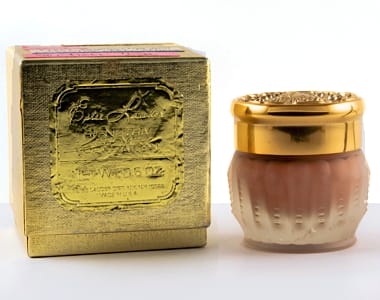
Estée Lauder Re-Nutriv Liquid-Creme Foundation.
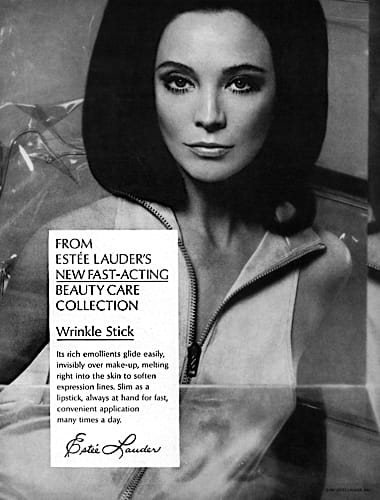
1967 Estée Lauder Wrinkle Stick.
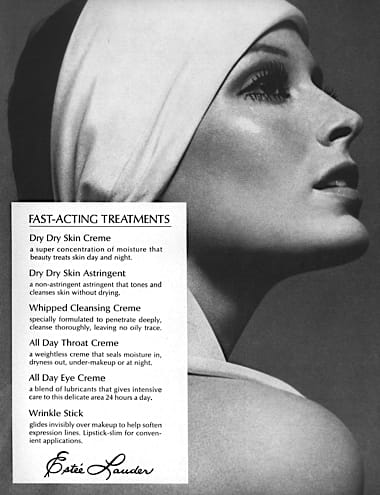
1968 Estée Lauder Fast-Acting Treatments.
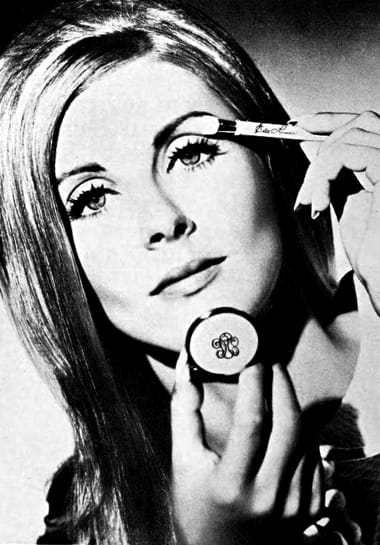
1968 Estée Lauder Eye Shadow Glow.
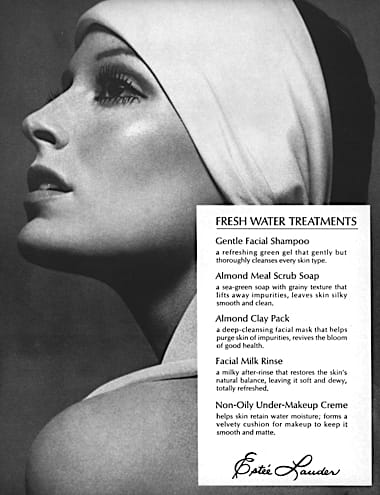
1968 Estée Lauder Fresh Water Treatments.
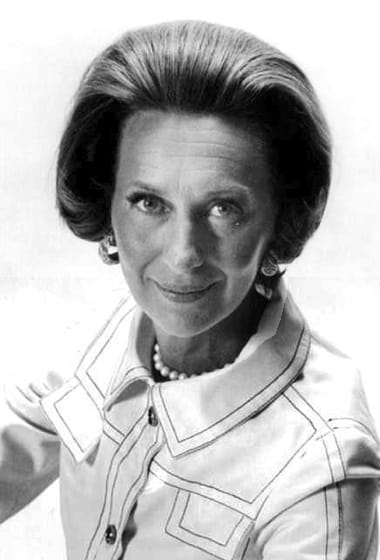
Carol Philips [1922-2006] brought in from Vogue wearing an original Clinique ‘lab coat’.
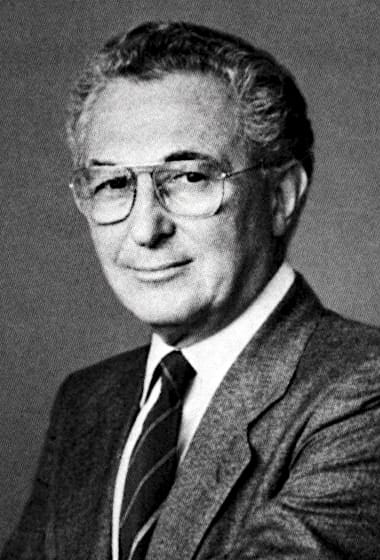
Dr. Norman Orentreich [1922-2019] the dermatologist credited with developing the Clinique range.
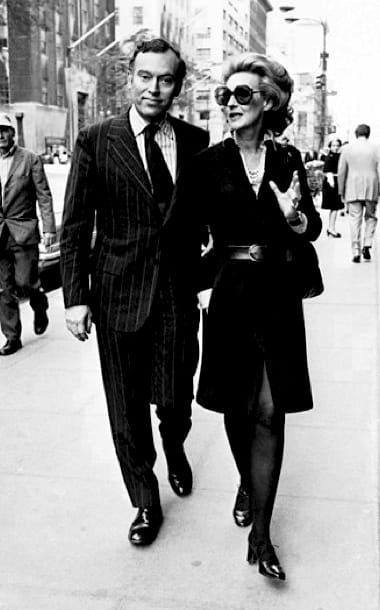
Leonard Lauder and Carol Philips.
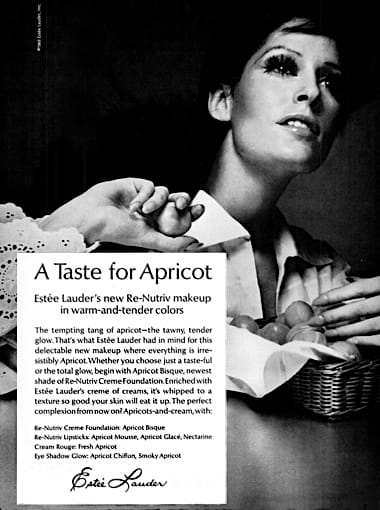
1969 Estée Lauder Apricot Bisque Re-Nutriv Creme Foundation; Apricot Mousse, Apricot Glace, and Nectarine Re-Nutriv Lipsticks; Fresh Apricot Cream Rouge; and Apricot Chiffon, and Smoky Apricot Eye Shadow Glow (UK).
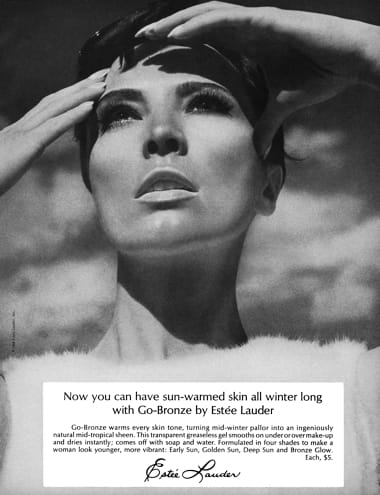
1969 Estée Lauder Go-Bronze.

1969 Estée Lauder Ultra-Violet Screening Creme.
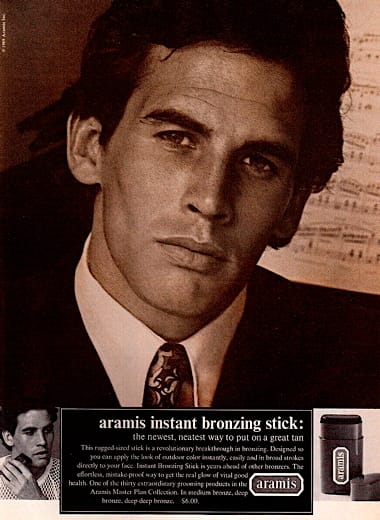
1969 Aramis Instant Bronzing Stick.
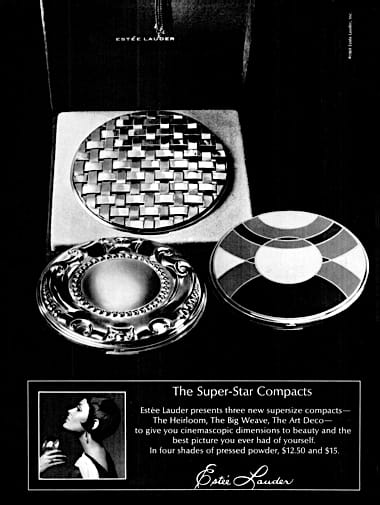
1969 Estée Lauder Big Weave, Heirloom, and Art Deco Compacts.
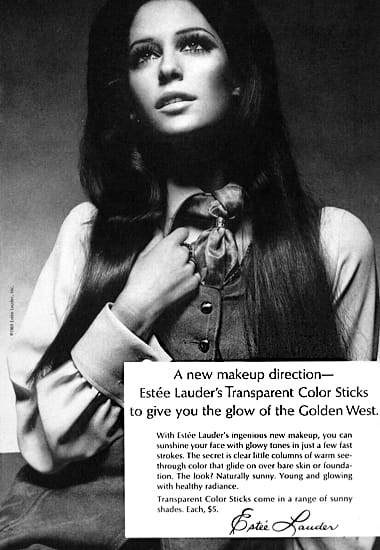
1969 Estée Lauder Transparent Color Sticks.
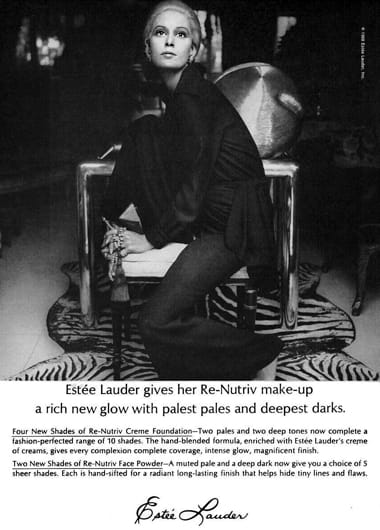
1969 Estée Lauder Re-Nutriv Creme Foundation and Face Powder.
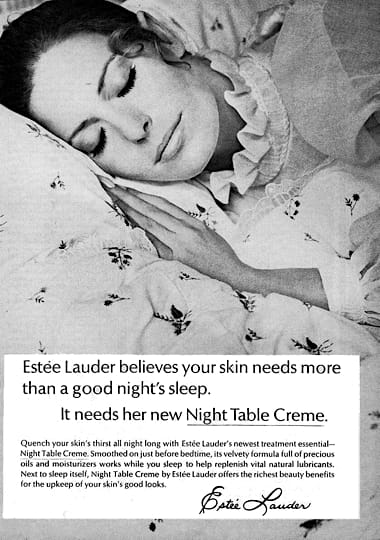
1969 Estée Lauder Night Table Creme.

1970 Estée Lauder Tender Cheek Tint added to Tender Lip Tint (1970) and Tender Makeup Tint/Base (1967) in the Little Nothings range.
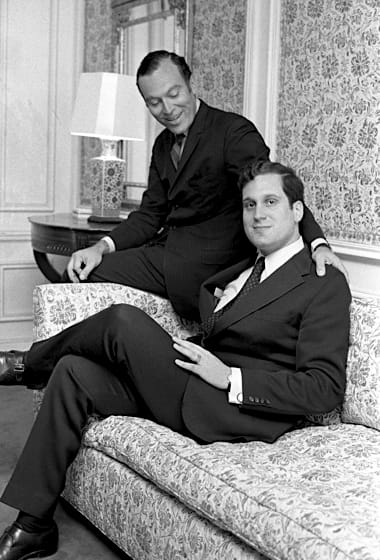
1969 Leonard and Ronald Lauder. Leonard joined the company in 1958, Ronald in 1964.

1970 Estée Lauder Ready-to-Wear Eye Makeup Collection.

1970 Estée Lauder Creme Pack.
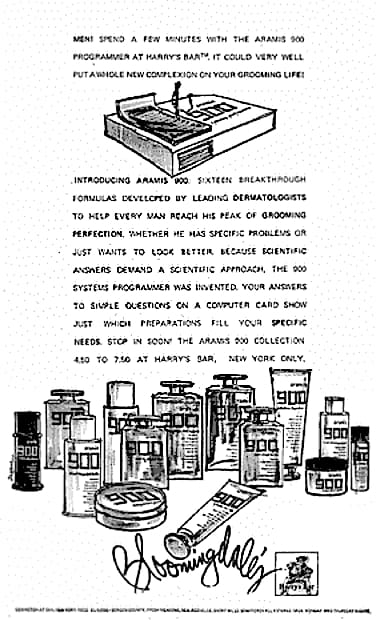
1970 Aramis 900 showing the Aramis 900 Programmer.
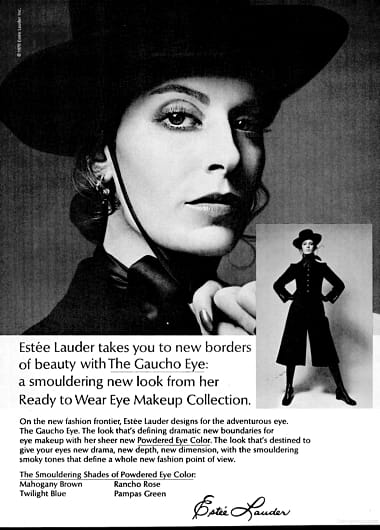
1970 Estée Lauder The Gaucho Eye.
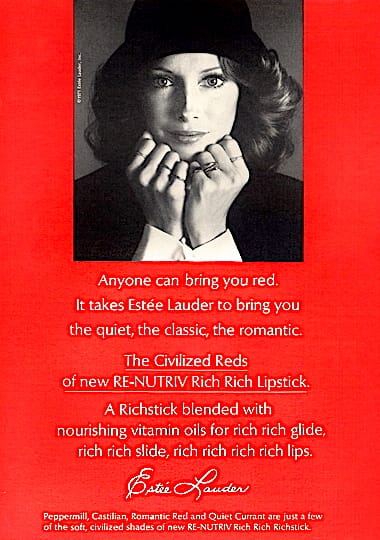
1972 Estée Lauder Re-Nutriv Rich Rich Lipsticks.
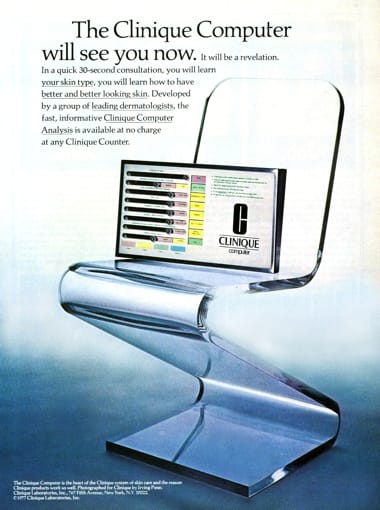
1977 Clinique.
